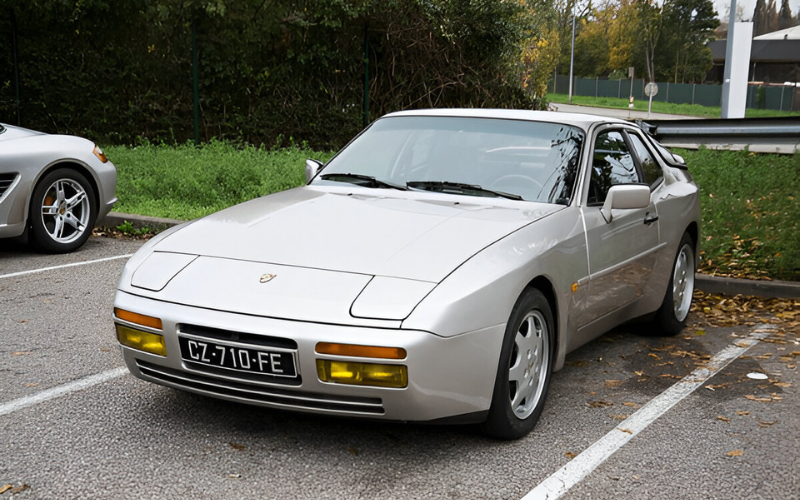Introduction
The Porsche 944 remains one of the most iconic and accessible classics from the German automaker. Built during the 1980s and early 1990s, the 944 offers a unique blend of performance, design, and affordability that continues to attract both seasoned collectors and first-time Porsche enthusiasts. This article explores the story behind the Porsche 944, its standout features, and why it continues to hold a special place in the automotive world.
The Origins and Legacy of the Porsche 944
How the 944 Emerged from Porsche’s 1980s Strategy
During the early 1980s, Porsche was looking for ways to diversify its lineup beyond the legendary 911. The brand wanted to create a model that was both more affordable and practical, yet still carried the performance DNA Porsche was known for. The Porsche 944 was the result of this approach—a front-engine, rear-wheel-drive coupe that blended balance, power, and Porsche engineering into a compelling package.
Initially introduced in 1982, the 944 filled the gap between the entry-level 924 and the more expensive 911. With its improved handling and more powerful engine, it quickly gained a strong following, especially among younger drivers looking to own their first Porsche.
Evolution from the 924 to the 944 Turbo
The 944 was based on the 924 but with major upgrades. It featured flared fenders, upgraded suspension, and a more powerful inline-four engine developed by Porsche. The introduction of the 944 Turbo in 1985 marked a turning point. It pushed the car into true performance territory, offering near-supercar levels of speed for a much more accessible price. Later models like the 944 S and 944 S2 further refined the platform, improving everything from engine output to interior comfort.
Design and Engineering That Made It Stand Out
Aerodynamics, Styling, and Interior Innovations
One of the defining traits of the Porsche 944 was its sleek, wedge-shaped body. Designed with aerodynamics in mind, the car featured a low profile, pop-up headlights, and a sloping rear hatchback that gave it a modern yet timeless look. The design was not just about style—it helped improve stability at high speeds and contributed to the car’s balanced weight distribution.
Inside, the 944 offered a more refined interior compared to earlier Porsche models. With well-bolstered seats, clean dash layout, and quality materials, the cabin was both functional and comfortable. Porsche also paid attention to driver ergonomics, making the car a pleasure to operate over long distances.
The Balance of Front-Engine, Rear-Wheel Drive
Unlike the rear-engine 911, the Porsche 944 featured a front-mounted engine with rear-wheel drive and a rear transaxle. This setup provided near-perfect weight distribution, which translated into excellent handling. The car felt planted in corners and inspired confidence, even for novice drivers. This engineering decision is one of the reasons the 944 is still admired for its driving dynamics.
Performance Specs and Driving Experience
Engine Variants and Horsepower Over the Years
The base Porsche 944 came with a 2.5-liter inline-four engine producing around 143 horsepower in early models. Over time, Porsche introduced several versions with more power and advanced engineering. The 944 Turbo, also known as the 951, featured a turbocharged engine producing up to 250 horsepower in its later years. The 944 S2, released in 1989, offered a 3.0-liter naturally aspirated engine, one of the largest four-cylinder engines at the time, delivering a smooth and engaging ride.
Each model offered a unique experience, but all stayed true to the car’s roots—sharp handling, responsive steering, and a low driving position that made every trip enjoyable.
What It’s Like Behind the Wheel of a 944 Today
Driving a Porsche 944 today still feels engaging and special. The car offers a raw connection to the road, something modern vehicles often lack due to electronic filters. Enthusiasts appreciate its analog feel—manual steering in some models, mechanical feedback through the pedals, and a gearbox that rewards precision.
While not as fast as today’s sports cars, the 944 holds its own with excellent cornering ability and a driving experience that’s hard to match in its price range.
Ownership, Maintenance, and Reliability
Common Issues and What to Watch For
Like any classic car, the Porsche 944 comes with a few quirks. Common issues include timing belt wear, oil leaks, and aging electrical components. Fortunately, many parts are still available, and there’s a strong community of owners who share advice and resources.
Buyers should be cautious of poorly maintained models. Service history is important, especially regarding the timing belt and water pump, which need regular replacement to avoid engine damage.
Cost of Ownership in 2025
In 2025, owning a Porsche 944 can be surprisingly affordable—if you choose the right car and stay on top of maintenance. Insurance is generally reasonable, and many repairs can be done by knowledgeable DIYers or specialty shops. The rising popularity of vintage cars means values are increasing, but the 944 still offers one of the best price-to-performance ratios among classic European sports cars.
The Porsche 944 in the Collector Car Market
Pricing Trends and Value Appreciation
Over the past decade, the Porsche 944 has gained steady interest in the collector market. Prices for well-maintained models have appreciated, especially for the Turbo and S2 variants. While early base models can still be found for under $15,000, pristine examples or limited editions can reach over $30,000, depending on mileage and condition.
Enthusiasts recognize the 944’s importance in Porsche’s history, which has helped fuel its value in the vintage car market.
Which Models Are Most Desirable?
Among collectors, the 944 Turbo and 944 S2 Cabriolet are considered the most desirable due to their rarity and performance. Limited editions like the Turbo S or the 944 Celebration Edition also fetch premium prices. However, even the base models are appreciated for their clean styling and balanced driving feel.
Conclusion
The Porsche 944 continues to be a beloved classic for good reason. It blends stylish design, excellent handling, and the Porsche name into a package that’s still within reach for many enthusiasts. Whether you’re looking for your first sports car or adding a classic to your collection, the 944 offers timeless appeal and driving enjoyment that’s hard to beat.
FAQ About the Porsche 944
Q1: Is the Porsche 944 a good car for beginners?
Yes, it’s often recommended for new sports car owners due to its balanced handling, reliability, and approachable performance.
Q2: What are the differences between the 944, 944S, and 944 Turbo?
The base 944 offers solid performance, the 944S added more power and refinement, while the Turbo introduced a significantly faster, boosted engine and improved handling.
Q3: How reliable is the Porsche 944 for daily driving?
With proper maintenance, the 944 can be very reliable, but it’s still an older vehicle, so regular checks and timely repairs are important.
Q4: What years of the Porsche 944 are considered the best?
Most enthusiasts favor the later models—1987 to 1991—due to improved build quality and performance, especially the Turbo and S2 versions.

